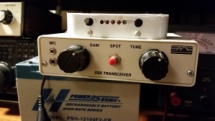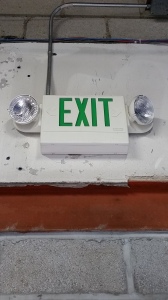When the power goes out, are you ready? A lot of people are counting on nice and shiny generators to “get them through”. That’s fine and good if you have a supply of fuel, extra parts and a mechanic on your team but……What if you were away from home or your generator breaks? Do you know how to “find” power? It’s all around you everyday you just have to know where to look.
Let me start by saying there is nothing wrong with “nice and shiny generators”. I have one and it is great! We are talking about if it’s not available or if it is out of service. Also this is not an article on solar power, that’s a different post. Lets say you are at the office and things get REAL…….. You have your HT but the battery pack is getting low and there is no way to charge it. Look around, you need 12 volts DC fast. Where are you going to find it? In this post, I am not teaching an action but a way to look at things around you; a skill not a specific motion. If you are in an office, the first thing to look for might be a computer UPS (uninterrupted power supply). If things are that, bad use it. Next thing to look for are exit signs.
Most of these signs have either a 12 volt or 6 volt sealed battery in them to maintain operation when power goes off. You can harvest the battery and with the right skills, interface it with your radio. If it is a 6 volt battery, find two and wire them in series. One of these batteries will run your HT, CB or Yaesu FT-817 a long time. Of course if you need a bigger power source and it is available, abandoned cars, trucks and motor homes all have 12 volt batteries. What about that old lawn tractor?? Yep, 12 volts there too. The trick is to use low current draw gear.  Think QRP…….. All of those 1500 watt HF stations are gonna go quiet, real fast. In an event like this your ingenuity and operating skills will shine. There are a lot of fancy power packs out there but they will do you no good unless they are with you, learn to “run what you brung”. Use your resources and adapt. You need a QRP HF dipole? You have your radio but no wire? Think old extension cord, think miles oCAT 5 cable up in the drop ceiling. This stuff is everywhere.
Think QRP…….. All of those 1500 watt HF stations are gonna go quiet, real fast. In an event like this your ingenuity and operating skills will shine. There are a lot of fancy power packs out there but they will do you no good unless they are with you, learn to “run what you brung”. Use your resources and adapt. You need a QRP HF dipole? You have your radio but no wire? Think old extension cord, think miles oCAT 5 cable up in the drop ceiling. This stuff is everywhere.
Here are some tools of the trade you can keep close at hand to “borrow” power:
1. Good multi tool (Leatherman or Swisstool)
2. Good flashlight (Stream Light or Maglite etc.)
3. A 12 volt “cigarette lighter to clamps” cable (see pictures)
4. 12 volt connections for your radio gear
5. 88 tape (electrical tape)
6. Small length of wire (this can be field expedient)
7. Knowledge of what to do………
Practice now. Tomorrow may be too late. Think outside the box. Fancy gear is great but skills beat gear any day. Good luck. Dialtone OUT.
https://dialtoneblog.wordpress.com/2015/05/07/grid-down-power-up/









“Let me start by saying there is nothing wrong with “nice and shiny generators”.
Except that many of them make enough racket to wake the dead.
Makes it tough to be invisible.
Having gone through 8 (i am not making that number up) nice new shiny generators in ten years i can assure you that it wont just be lack of fuel that makes them go quiet. They seem to be mostly made in China and they will die when giving any sort of real duties to perform.
That I can believe, uL.
the biggest problem with most generators built today is not the place they are made, it is how they are running them.. most run at 3600RPM.. another thing is that they are putting 5W oil in them which runs off the parts and does not adhere to the extent to provide good lubrication..
but the thing on the new generators that cause the most noise is not the exhaust like most would think, it is how they have a lot of them balanced inside..
somewhere in their infinite stupidity some small engine companies decided to stop trying to balance the engine out with the crank shaft weights and decided to add in a reciprocating hammer weight to oppose the piston movements.. this coupled with the 3600RPM these engines will literally beat themselves to pieces.. B&S is the worlds worst for this..
if you can find one of the older Onan or Kholer generators out of a motor home.. most of these are rated at 1800RPM and can be quietened to where you cant hear them hardly.. they do weigh a bit more for the same output but are built like tanks and most have very little hours on them..
but the article is good and dandy for the first few months of a SHTF situation, but sooner or later even batteries self discharge or are discharged in the system they are installed in.. mot cars have so many electronics now that the battery will be dead in a month or two.. a week of the power being out and the Exit signs and emergency lights will also be discharged..
even batteries are not long term sources of electricity in the field..
but if your going to salvage power from these sources then i would suggest a 12V adapter with multiple output capability to run lesser voltage items on..
and contrary to popular belief, you can run small transistor radio from an earth battery or even a D-cell with 0.5Vdc left in it.. an earth battery is nothing more than 2 metals (magnesium anode rod from water heater & copper pipe) drove in the ground and a load connected between.. you can build individual cells and treat them just like regular batteries with series and parallel configuration..
the output of the earth battery is low (1.5Vdc at 20-30mA for a small setup) but can put out 24hr a day for a very long time (months or even years).. it will not run your tv or electric stove, but with a small boost converter you can charge small ni-cad batteries and run small LED lights with it..
with the boost converter i designed and a D-cell (or even a AA) i have run a AM/FM/SW radio for hours on a battery that only read 0.7Vdc.. the radio would normally run on 6 C-cells.. here is a AM/FM/CD radio running off of one of my converters.. https://www.youtube.com/watch?v=pPr-VbxQ2eo i can also run a CB radio with this setup or trickle charge bigger batteries..
i got a very low draw system that has been running an LED light for over 2 months off of a home made crystal battery….
but i built my circuits and tweaked them to run off earth batteries and hopefully some atmospheric electricity scavenging setups…
here is something very interesting that would be good for SHTF and power outage situations… how about a LED light that runs without any batteries..
https://scontent.xx.fbcdn.net/hphotos-xfp1/v/t1.0-9/11182043_834647459956571_1079751835526489210_n.jpg?oh=148eb17ae8052a4dab7d4b0473eb6c81&oe=55D9CB2D
here is the setup that has been running for 2 months that shows the home made battery with a current draw of 4.97mA.. the LEDs are rated at 7V and 200mA yet the circuit that is running them is only drawing 4.97mA..
https://scontent.xx.fbcdn.net/hphotos-xpa1/v/t1.0-9/11156367_833236890097628_8133677424977147417_n.jpg?oh=fe95f6039f5e7b4ec89a45e483cafe9d&oe=55984AB1
this is the first generation circuit i rearranged to run off of earth batteries and other low voltage sources..
https://scontent.xx.fbcdn.net/hphotos-xfa1/v/t1.0-9/10933907_832674253487225_3180963154292841924_n.jpg?oh=54c3badf8bdafcf4bd2390197c82054b&oe=55AACEC1
but here is a way to build a simple yet powerful battery from items bought at the grocery store and hardware store..
you’ll need a glass jar or plastic jar (i used a 10oz dill relish jar).. a piece of magnesium ( magnesium concrete float or anode rod for water heater). some carbon sheet or a carbon block. (i used 2 inch wide carbon brush material from a large DC motor for my carbon plates.. graphite will also work) potassium chloride which is also known as “No Salt” brand salt substitute..
prepare the battery by mounting the magnesium and carbon where you want them and fixing wire to them. (i set it up where the carbon plates were stationary and the magnesium rod slipped in for easy replacement)
mix one or two ounces of potassium chloride salt substitute per 10oz of water and then cover the plates..
drill the lid and run the wires through and screw the lid on and your done..
( note, don’t seal the battery off completely. the galvanic reaction causes gas to form and will pressurize the glass jar if you do. just leave in a pinhole or add in a one way valve).
depending on the size of the battery you’ll get anywhere from 1A to well over 3A at 1.5Vdc per cell.. should be enough to run your small electronics if you series them till you get enough voltage..
im thinking you can use copper tube for the positive electrode instead of the carbon. i have not tried this out yet so don’t take my word for it.. i just took the two materials that were the farthest from each other on the galvanic scale that i had here to build this setup…
there is a very old method to sealing the liquid off to prevent evaporation in batteries and old salt water capacitors that used to be used in the 1800s.. what you did was to pour a thin oil on top of the water and it would ride on top of the water and prevent it from evaporating.. this also prevented arcing between electrodes for the old salt water capacitors..